Paifang
A paifang, also known as a pailou, is a traditional style of Chinese architectural arch or gateway structure. Evolved from the Indian subcontinent's torana through the introduction of Buddhism to China, it has developed many styles and has been introduced to other East Asian countries, such as Korea, Japan, and Vietnam.[1]
| Paifang | |||||||||||||||||||||||||
|---|---|---|---|---|---|---|---|---|---|---|---|---|---|---|---|---|---|---|---|---|---|---|---|---|---|
.jpg.webp) | |||||||||||||||||||||||||
| Chinese | 牌坊 | ||||||||||||||||||||||||
| Literal meaning | memorial archway gate | ||||||||||||||||||||||||
| |||||||||||||||||||||||||
| Pailou | |||||||||||||||||||||||||
| Simplified Chinese | 牌楼 | ||||||||||||||||||||||||
| Traditional Chinese | 牌樓 | ||||||||||||||||||||||||
| Literal meaning | memorial archway edifice | ||||||||||||||||||||||||
| |||||||||||||||||||||||||
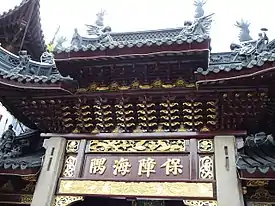
Etymology
The word paifang (Chinese: 牌坊; pinyin: páifāng) was originally a collective term for the top two levels of administrative division and subdivisions of ancient Chinese cities. The largest division within a city in ancient China was a fang (坊; fāng), equivalent to a current day ward.[2] Each fang was enclosed by walls or fences, and the gates of these enclosures were shut and guarded every night. Each fang was further divided into several pai (牌; pái; 'placard'), which is equivalent to a current day (unincorporated) community. Each pai, in turn, contained an area including several hutongs (alleyways).
This system of urban administrative division and subdivision reached an elaborate level during the Tang dynasty, and continued in the following dynasties. For example, during the Ming dynasty, Beijing was divided into a total of 36 fangs. Originally, the word paifang referred to the gate of a fang and the marker for an entrance of a building complex or a town; but by the Song dynasty, a paifang had evolved into a purely decorative monument.
Origin
The ancient torana is sacred gateway architecture found all over the Indian subcontinent. It has influenced the gateway architecture further across asia via the Silk Road transmission of Buddhism; Chinese paifang gateways[3] Japanese torii gateways,[3][4] Korean Hongsalmun gateway,[5] and Sao Ching Cha in Thailand[4] have been derived from the Indian torana. The functions of all are similar, but they generally differ based on their respective architectural styles.[6][7] Chinese paifang derived from the torana temple-gate in ancient India,[8] has taken on traditional Chinese architectural characteristics such as multi-tiered roofs, various supporting posts, and archway-shapes of traditional gates and towers.[9][10]
During the Tang dynasty, it was called a wutoumen (烏頭門; wūtóumén; 'black top gate'), because the top of the two posts were painted black. A wutoumen was reserved for officials of rank 6 or higher.
The construction of wutomen was standardized in the Yingzao Fashi of the mid Song dynasty.[11] It consisted of two posts and a horizontal beam forming a frame and two doors. By the Ming and Qing dynasties, it was called a pailou or paifang, and evolved into a more elaborate structure with more posts and gates, with a superstructural gable on top; the highest rank was a five gate-six post-eleven gable pailou.
Style
Paifangs come in a number of forms. One form involves placing wooden pillars onto stone bases, which are bound together with wooden beams. This type of paifang is always beautifully decorated, with the pillars usually painted in red, the beams decorated with intricate designs and Chinese calligraphy, and the roof covered with coloured tiles, complete with mythical beasts—just like a Chinese palace. Another form of paifang is in the form of true archways made of stone or bricks; the walls may be painted, or decorated with coloured tiles; the top of the archways are decorated like their wooden counterparts. Yet another form of paifang, built mainly on religious and burial grounds, consists of plain white stone pillars and beams, with neither roof tiles nor any coloured decoration, but feature elaborate carvings created by master masons. Another form is in the Han dynasty style, and is two matching towers, such as in Beihai.
Outside of China, the paifang has long been the symbol of Chinatowns. The largest outside of China is in the United States: Friendship Archway at 14.50 m (47 ft 7 in) tall and 23 m (75 ft) wide, completed in 1986 at H and 7th in Washington D.C.'s Chinatown.[12] In Europe, the largest paifang spans Nelson Street in Liverpool, completed in 2000 and standing 13.5 m (44 ft) tall.[13] The first paifang in the United States was raised in 1915 as a temporary installation for the Chinese pavilion of the Panama–Pacific International Exposition in San Francisco,[14] and the oldest still standing was erected in 1938 for Los Angeles, Chinatown West Gate on Hill Street;[15] it was listed as a city Historic-Cultural Monument (#825) along with its counterpart, Chinatown East Gate (1939, #826) in November 2005.[16]
In the past, "Chastity Paifangs" were given to widows who remained unmarried till death, praising what was seen as loyalty to their deceased husbands.
Gallery
Chinese paifang
_from_Han_Dynasty_(202_BCE_%E2%80%93_220_CE)_across_a_Street_Lined_with_Small_Shops._Hanzhong%252C_Shaanxi_Province%252C_China%252C_1875_WDL2092.png.webp) Ornamental Gateway (Pailou) from Han Dynasty (202 BCE – 220 CE) across a Street Lined with Small Shops. Hanzhong, Shaanxi Province, China, 1875 WDL2092
Ornamental Gateway (Pailou) from Han Dynasty (202 BCE – 220 CE) across a Street Lined with Small Shops. Hanzhong, Shaanxi Province, China, 1875 WDL2092
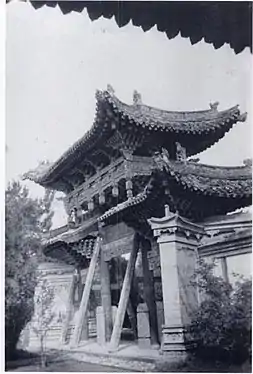 A paifang photographed in Gansu Province (1933).
A paifang photographed in Gansu Province (1933). Paifang of Wuhan University (1920).
Paifang of Wuhan University (1920). Paifang at the Cemetery of Confucius, tomb of Lady Yu, wife of Kong Xianpei (72nd generation) in Qufu, China.
Paifang at the Cemetery of Confucius, tomb of Lady Yu, wife of Kong Xianpei (72nd generation) in Qufu, China. Paifang in the Chiang Kai-Shek Memorial Square (now Liberty Square) in Taipei.
Paifang in the Chiang Kai-Shek Memorial Square (now Liberty Square) in Taipei.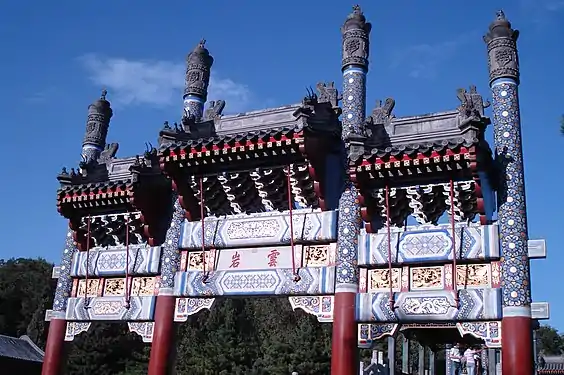 Decorated paifang at the Summer Palace in Beijing.
Decorated paifang at the Summer Palace in Beijing.
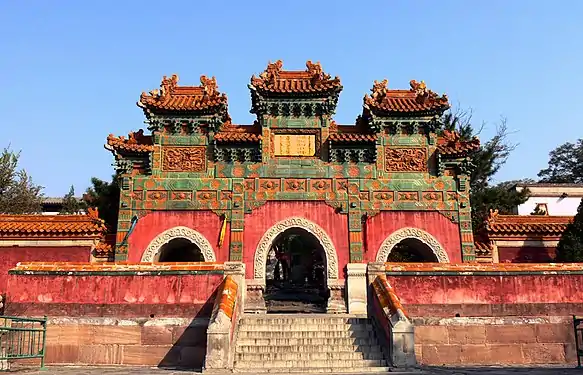 Colour glaze gateway at Puotuo Zongcheng temple, Chengde.
Colour glaze gateway at Puotuo Zongcheng temple, Chengde. Paifang in Xidi.
Paifang in Xidi. Pailou at the entrance to Qiandao Lake Scenic Area
Pailou at the entrance to Qiandao Lake Scenic Area
 Paifangs at the entrance to Yonghe Temple, Beijing
Paifangs at the entrance to Yonghe Temple, Beijing Pailou at the China Martial Arts Hall, Jinshitan, Dalian
Pailou at the China Martial Arts Hall, Jinshitan, Dalian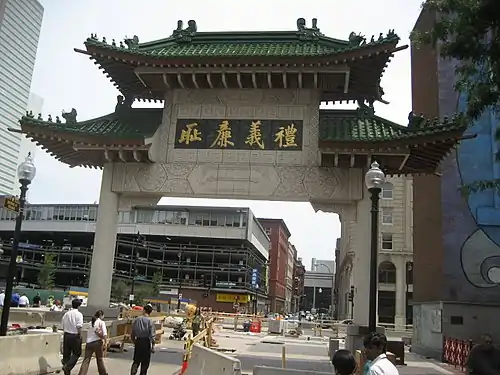 Paifang at the entrance to Chinatown in Boston, Massachusetts. This paifang was a gift from Taiwan[17]
Paifang at the entrance to Chinatown in Boston, Massachusetts. This paifang was a gift from Taiwan[17]
 Pailou at Dunedin Chinese Garden, New Zealand.
Pailou at Dunedin Chinese Garden, New Zealand.
Asian sacred gateway styles originally derived from the Indian Torna
- Asian sacred gateway styles originally derived from the Indian Torna
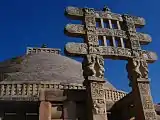 Indian Torana of Sanchi Stupa, a UNESCO World Heritage Site, dating to the period of the Mauryan Empire (3rd century BC), the torana itself dates to the Satavahana period, in the 1st century CE
Indian Torana of Sanchi Stupa, a UNESCO World Heritage Site, dating to the period of the Mauryan Empire (3rd century BC), the torana itself dates to the Satavahana period, in the 1st century CE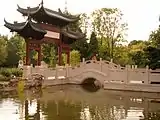 A Chinese Paifang (pailou)
A Chinese Paifang (pailou) Japanese Torii at Itsukushima Shrine, a UNESCO World Heritage Site Japan, where the Indian Hindu goddess Saraswati is worshipped as the Buddhist-Shinto goddess Benzaiten
Japanese Torii at Itsukushima Shrine, a UNESCO World Heritage Site Japan, where the Indian Hindu goddess Saraswati is worshipped as the Buddhist-Shinto goddess Benzaiten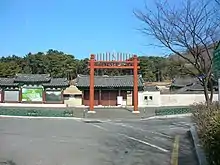 Korean Hongsalmun, in red, at the tomb of legendary Korean Emperor Suro of Geumgwan Gaya and his legendary wife Queen Heo Hwang-ok believed to be an Indian princess and mother of all Koreans of Heo and Kim clans
Korean Hongsalmun, in red, at the tomb of legendary Korean Emperor Suro of Geumgwan Gaya and his legendary wife Queen Heo Hwang-ok believed to be an Indian princess and mother of all Koreans of Heo and Kim clans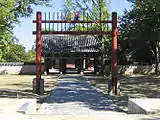
See also
References
- A.H. Longhurst (1995). Story Of The Stupa. Asian Educational Services. pp. 17–. ISBN 978-81-206-0160-4.
- Steinhardt, Nancy Shatzman (2019). Chinese Architecture: A History. Princeton University Press. p. 729. ISBN 9780691191973.
- Albert Henry Longhurst (1992). The Story of the Stūpa. Asian Educational Services. p. 17. ISBN 978-81-206-0160-4.
- Scheid, Bernhard. "Religion in Japan". Torii (in German). University of Vienna. Retrieved 12 February 2010.
- A.H. Longhurst (1995). Story Of The Stupa. Asian Educational Services. pp. 17–. ISBN 978-81-206-0160-4.
- Ronald G. Knapp (2000). China's old dwellings. University of Hawaii Press. p. 85. ISBN 0-8248-2214-5.
- Simon Foster; Jen Lin-Liu; Sharon Owyang; Sherisse Pham; Beth Reiber; Lee Wing-sze (2010). Frommer's China. Frommers. p. 435. ISBN 978-0-470-52658-3.
- Joseph Needham, Science and Civilization in China, Vol 4 part 3, p137-138
- Ronald G. Knapp (2000). China's old dwellings. University of Hawaii Press. p. 85. ISBN 0-8248-2214-5.
- Simon Foster; Jen Lin-Liu; Sharon Owyang; Sherisse Pham; Beth Reiber; Lee Wing-sze (2010). Frommer's China. Frommers. p. 435. ISBN 978-0-470-52658-3.
- Li Jie. "The Construction of Wutoumen". Yingzao Fashi 營造法式. 6: Minor Woodwork I.
- "Friendship Archway, (sculpture)". Smithsonian Institution Research Information System. Retrieved 18 February 2011.
- "Liverpool's Chinese arch ten years standing". BBC. 19 February 2010. Retrieved 18 February 2011.
- Allen-Kim, Erica (Spring 2013). "The Political Economy of Chinatown Gates". Pidgin. No. 15. Princeton University School of Architecture. Retrieved 29 April 2020.
- Exploring Chinatown: Past and Present (PDF) (Report). Los Angeles Conservancy. Retrieved 29 April 2020.
- Historic-Cultural Monument (HCM) List (PDF) (Report). Department of City Planning, City of Los Angeles. April 21, 2020. Retrieved 29 April 2020.
- http://www.boston.com/yourtown/boston/downtown/gallery/chinatown_tour/
External links
 Media related to Paifang at Wikimedia Commons
Media related to Paifang at Wikimedia Commons